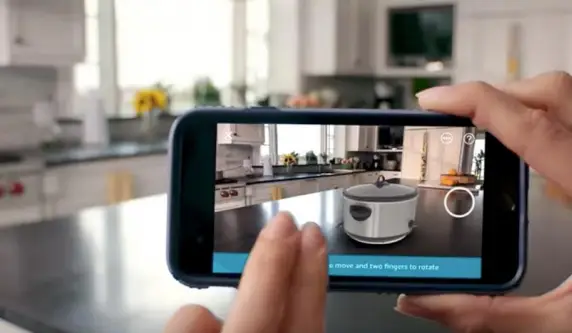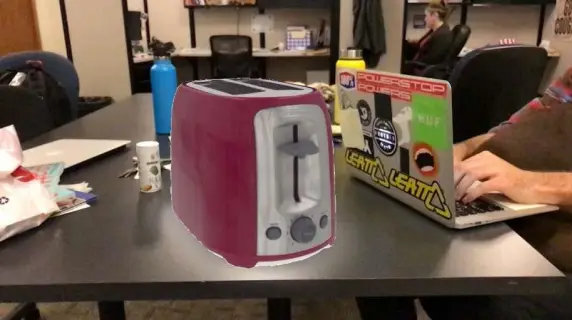Amazon stepping into Augmented Reality with Amazon App
Amazon is once again transforming the way that people shop on their mobile devices, thanks to virtual reality.
Amazon has started its Black Friday deals early, as many discounts can already be had as of Wednesday. Along with that rollout, Amazon announced that starting this holiday season shoppers will be able to turn on augmented reality (AR) in the Amazon App on iPhone iOS to view items in a more realistic way. The augmented reality seeks to create a much more personal and realistic shopping experience.

Here’s Amazon’s official statement on the matter:
“Whether customers are buying a sofa or a kitchen appliance, they can overlay it onto their existing living space, move it and rotate it to get a full 360-degree peek in a live camera view to make sure it fits their style and aesthetic,” Amazon’s announcement read in part.
While utilizing the Amazon App, customers will be able to see what a product would look like in real life before they make the purchase. Customers can move and rotate the object up to 360 degrees at the touch of a screen. Check it out in the image below, which is provided by Amazon.
It looks pretty good, doesn’t it? However, it looks like the actual early version of the app may have some bugs, as evidenced in this user-snapped photo.
The image isn’t nearly as crisp in this photo, but the usefulness of such a feature is pretty clear. Amazon also released a promotional video for its new feature, which shows off everything that the augmented reality add-on can do.
The function will be usable for anyone with an iPhone 6S (or more recent) with iOS 11. While the current plan is for users to have this feature through the holiday season, it could transform the way people shop on Amazon for good.
Amazon’s integration of augmented reality is genius and adds a whole new dimension to shopping, making the customer’s experience more interactive and more intuitive.
Augmented reality has become a very popular new technology. According to a study conducted by the Huffington Post, $1.1 billion was spent on AR in 2016. It has been used in many different ways since its inception, most notably in video games and news.

Pokémon Go saw a stratospheric boom in popularity thanks to its inclusion of augmented reality when the mobile game launched in July 2016. Even though downloads for the iPhone game have stalled, augmented reality has taken off around the industry.
Augmented Reality has existed, Amazon App looks to capitalize
Augmented reality has been marketed as a form of entertainment, but Amazon is turning it into something else: a boon for business.
Amazon isn’t the only one who has tried this out though, according to Business Insider.
AR View helps Amazon keep pace with competitors that have introduced similar features. iOS 11’s ARKit has enabled a number of retailers to introduce AR tools like Amazon’s AR View. As a result, 20% of consumers already expect retailers to have such a feature, and 49% expect it by the end of March 2018.
AR View fulfills this requirement for Amazon, which is important since companies like Wayfair and Ikea already have AR tools through iOS 11, and they compete directly with Amazon for online furniture sales. Amazon likely wants to defend its furniture sales given that the home and kitchen categories accounted for 15% of its sales growth in 2016, and should benefit from consumers’ interest in AR products with this move.
What is the use of Augmented Reality?
For now, the augmented reality feature will mostly be used for appliances, electronics, furniture, and toys. Those are the most realistic uses for the function anyway, considering those are major items that people would place in their households.
It’s interesting to see Amazon and Apple team up for this feature. In some departments, the two are competitors. But the two major companies seem to have found a happy marriage in the shopping world, in which Apple has no personal stake.
The function can only be used on Apple’s devices. Therefore, the partnership should increase sales for Apple’s iPhone too. Both sides get major business benefits from the relationship.
Furthermore, the app should help customers make smarter decisions while shopping. Now buyers will able to visualize an object in their home before making the purchase, which should in theory lead to fewer returns — as long as the image of the product that the seller provides is honest and authentic.
That distinction may pin more responsibility on the seller to provide an accurate image of the product in future sales. If a customer views an item through the augmented reality app and likes it, and then it shows up to the customer’s house and looks different than it did in the app, that could be a problem for sellers.
On the other hand, the addition of the function in the app could lead to fewer customers making purchases they would later regret, which would lead to fewer returns in the first place. It should increase the likelihood that someone really likes the product before they buy it, which makes a happier customer and a happier seller.
How far will Amazon go?
It’ll be interesting to see how Amazon continues to build on this concept. Amazon may not be the first company to implement this feature, but they’re certainly the biggest oe. That could cause a major revolution in the way that we shop. I wouldn’t be surprised if other major online sales corporations follow suit in the near future.
While the function of the app is currently limited to a handful of different kinds of products at Amazon, it could expand to encompass almost everything over time. It might not take very long to get there, either. That could transform the way people buy and the way that people sell.
